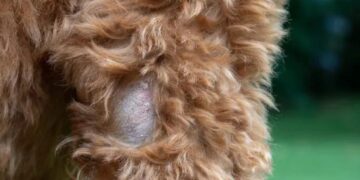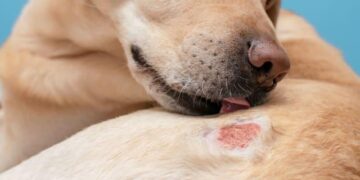Table of Contents
Section 1: The Unraveling—When Your Cat Becomes a Stranger in Their Own Skin
I have spent the better part of two decades in veterinary research, poring over cellular mechanisms and immunological pathways.
I’ve co-authored papers, presented at conferences, and prided myself on a rational, evidence-based approach to animal health.
But none of that prepared me for the quiet horror of watching my own cat, a sleek silver tabby named Leo, begin to systematically destroy himself.
It didn’t happen overnight.
It was an insidious creep of misery.
It started with an occasional, frantic scratch behind the ear.
Then it became a constant, obsessive grooming of his flanks.
Within a few months, Leo, once a picture of feline grace, was a mess of raw, weeping skin and patchy fur.
The itching, a condition veterinarians call pruritus, was centered on his head and neck, a classic sign that something was terribly wrong.1
Soon, small, pale, fluid-filled lumps erupted across his skin, which then became tiny, crusty scabs—a textbook presentation of miliary dermatitis.3
His once-plush coat grew dull and thin.
The misery wasn’t just skin deep; it invaded his gut, manifesting as intermittent bouts of vomiting and diarrhea, symptoms seen in up to 15% of cats with food allergies.1
My professional training kicked in immediately.
The signs pointed overwhelmingly to a cutaneous adverse food reaction.
The solution, according to every textbook and clinical guideline, was clear: an elimination diet trial.
The principle is straightforward.
Over time, a cat’s immune system can become sensitized to common proteins in their food, most often beef, fish, and chicken.2
The strategy is to switch the cat to a food containing a “novel protein”—a protein source they have never been exposed to before, like venison, duck, or rabbit.1
The immune system, having never seen this new protein, shouldn’t recognize it as an enemy and, therefore, shouldn’t react.
I went by the book.
I sourced a premium, veterinarian-recommended, venison-based limited ingredient diet.
I was meticulous.
Leo ate nothing but the venison kibble and water.
No treats, no table scraps, no exceptions.
I explained to my family that a single bite of the wrong food could sabotage the entire eight-to-twelve-week trial.3
We were all on board, hopeful that this scientifically sound approach would bring my poor cat relief.
It didn’t.
In fact, things got worse.
The itching intensified.
New sores appeared.
The gastrointestinal upset continued.
My confidence as a researcher evaporated, replaced by the raw desperation of a pet owner watching their beloved companion suffer.
What was I missing?
This failure forced me to confront the deep, often unspoken flaws in the conventional approach.
My journey down this rabbit hole revealed three critical truths that every owner of an itchy cat needs to understand.
First is the flawed premise of the “novel protein treadmill.” The very idea that a “novel” protein is inherently safe is a misunderstanding of how allergies work.
An allergy is an inappropriate immune response to a previously encountered substance.3
A novel protein is simply a protein the cat hasn’t become allergic to
yet.
Once you start feeding a venison diet, you are exposing the cat’s immune system to venison proteins day after day.
For a cat with a genetic predisposition to developing allergies, you are simply starting the clock on the development of a new allergy—this time, to venison.8
This is why so many owners on internet forums describe a frustrating cycle: the venison works for a year, then the itching returns.
They switch to rabbit, which works for eight months.
Then they’re desperately searching for kangaroo or even alligator-based foods, constantly trying to stay one step ahead of their cat’s overactive immune system.9
It’s not a solution; it’s a temporary truce in a war you are destined to lose.
Second is the “contamination catastrophe” of over-the-counter (OTC) diets.
Many well-meaning owners, seeing “Limited Ingredient Diet” or “Grain-Free Rabbit Recipe” on a bag at the pet store, believe they are conducting a proper food trial.
This is a catastrophic mistake.
The manufacturing facilities that produce these OTC foods often use the same equipment for multiple product lines.10
The batch of “Rabbit & Pea” food might be made on the same line that just processed a “Chicken & Rice” formula.
Trace amounts of chicken protein—contaminants—can easily end up in the bag.
When the allergic cat reacts, the owner and veterinarian are dangerously misled.
They conclude, “The trial failed; Leo must be allergic to rabbit.” In reality, he reacted to the hidden chicken.
This not only wastes months and hundreds of dollars but actively corrupts the diagnostic process, pointing you away from the real culprit and leaving the animal to suffer.11
This is why prescription diets, with their stringent quality control and testing for contaminants, are not just a recommendation but a medical necessity for a reliable diagnosis.13
Finally, I was grappling with the “diagnostic quagmire” of Inflammatory Bowel Disease (IBD) versus a food allergy.
IBD is a condition where the gastrointestinal tract becomes chronically inflamed, leading to vomiting, diarrhea, and weight loss—the exact same GI signs Leo was showing.5
The terrifying reality is that a food allergy and IBD can look identical, not just in their clinical signs but even on a microscopic level in intestinal biopsies.15
A veterinarian often cannot definitively distinguish between the two without first performing a strict dietary trial.
The trial itself becomes a diagnostic tool.
If the symptoms resolve with a specialized diet, it points toward a food-responsive enteropathy.
If they don’t, it points toward IBD that may require more aggressive medical intervention like corticosteroids.16
I wasn’t just fighting a disease; I was fighting a mystery shrouded in clinical ambiguity.
My confidence was shattered, and Leo was paying the price.
Section 2: The “Invisible Man” Epiphany: Why Hiding in Plain Sight Beats a Disguise
I hit a wall.
The novel protein strategy had failed spectacularly.
Leo was miserable, I was exhausted, and my professional expertise felt like a cruel joke.
I was just another desperate pet owner, lost in a sea of conflicting advice and dwindling options.
I spent late nights staring at immunology textbooks, the pages blurring together.
The answer wasn’t there.
The answer, when it came, arrived not from a scientific journal, but from a completely unexpected place: the world of espionage.
I was trying to distract myself, watching a documentary about intelligence agencies and how they track threats.
It struck me with the force of a physical blow: I was thinking about Leo’s problem all wrong.
I started to build an analogy.
The feline immune system is like a hyper-vigilant, technologically advanced security agency—think MI6 or the CIA. Its sole purpose is to protect the “nation” (the cat’s body) from foreign invaders.
Its agents—antibodies and immune cells—are exquisitely trained to identify specific threats (allergens) based on their unique characteristics.4
In this framework, a common allergen like chicken protein is a known enemy agent whose mugshot is plastered all over the agency’s “Most Wanted” list.
The moment this agent tries to cross the border (the gut wall), alarms blare, and an all-out defensive response is launched.
My first strategy—the novel protein diet—was like taking that same enemy agent, giving him a fake mustache and a different coat, and sending him back to the border.
This is the “bad disguise” strategy.
The security checkpoint might be fooled for a short while.
The agent might even get through a few times.
But the agency’s analysts are relentless.
They’ll study the agent’s gait, his facial structure, the sound of his voice.
Sooner or later, they will recognize the underlying threat, update their files, and add the “new” face to the Most Wanted list.
The disguise is blown, and the alarms sound once again.
This is precisely what happens when a cat develops an allergy to a novel protein.
It’s a temporary deception, not a long-term solution.
Then, the epiphany landed.
What if the goal wasn’t to disguise the agent? What if the goal was to make him invisible?
This is the strategy of hydrolyzed protein.
It’s a completely different paradigm.
Hydrolysis doesn’t put a mask on the chicken protein.
Instead, it uses advanced biochemical technology to disassemble the agent at a molecular level.
It’s like breaking the spy down into millions of microscopic, unrecognizable pieces—a shoelace here, a cufflink there, a single strand of hair somewhere else.
When this cloud of tiny, disconnected fragments drifts past the security checkpoint, the system simply doesn’t see it.
The fragments are too small, too simple, and too broken to match any profile on the Most Wanted list.
They don’t trigger the alarms because, as far as the security agency is concerned, there is no one there.
The agent has become an invisible man, hiding in plain sight.
This analogy changed everything.
I realized the solution wasn’t about an endless, frustrating search for a protein my cat’s immune system didn’t know.
The solution was to use science to present protein in a form his immune system couldn’t see.
The focus shifted instantly from agricultural sourcing to molecular engineering.
I wasn’t looking for a new ingredient anymore.
I was looking for a new technology.
Section 3: The Science of Invisibility: A Deep Dive into Hydrolyzed Protein
Armed with my “Invisible Man” analogy, I dove back into the science, but this time with a new lens.
I wasn’t just reading; I was connecting the dots between the security agency and the cellular reality.
Understanding the science of hydrolysis isn’t just academic; it’s the key to grasping why this approach is so fundamentally different and more effective than simply swapping protein sources.
Subsection 3.1: Deconstructing the Threat Profile (The Pathophysiology)
First, we must understand the body’s security agents and how they identify a threat.
In a healthy cat, the immune system in the gut practices tolerance.
It recognizes food proteins as harmless and necessary.
But in a cat with a food allergy or IBD, this tolerance breaks down.8
The immune system mistakenly flags a harmless food protein—say, from chicken—as a dangerous invader.3
This misidentification triggers a specific cascade.
Specialized immune cells present fragments of the chicken protein to T-helper 2 lymphocytes (Th2 cells).
These Th2 cells then orchestrate an allergic response, signaling B-cells to mass-produce a specific type of antibody called Immunoglobulin E (IgE).8
Each of these IgE antibodies is, in effect, a highly specific “wanted poster” for chicken protein.
These IgE antibodies then travel through the body and attach themselves to the surface of mast cells, which are heavily concentrated in the skin and the lining of the gastrointestinal tract.17
These mast cells are like armed guards, now primed with the enemy’s profile.
The cat is now “sensitized.” The next time the cat eats chicken, the proteins travel to the gut and skin.
There, they bind directly to the IgE antibodies studding the surface of the mast cells.
This connection acts like a trigger, causing the mast cells to degranulate—a violent explosion that releases a flood of inflammatory chemicals, most notably histamine.17
It is this chemical flood that causes the intense itching, redness, swelling, and gastrointestinal inflammation that made Leo’s life a living hell.
Subsection 3.2: The Molecular Disassembly Plant (The Hydrolysis Process)
This is where the molecular disassembly plant—the hydrolysis process—comes in.
The goal of hydrolysis is not merely to make proteins smaller.
Its precise objective is to utterly destroy the allergenic epitope.
The epitope is the specific, three-dimensional part of the protein molecule that the IgE antibody—the “wanted poster”—is shaped to recognize and bind to.17
It’s the enemy agent’s unique facial features.
The process, known as enzymatic hydrolysis, uses water and specific proteolytic enzymes to systematically cleave the peptide bonds that link amino acids together, breaking large, complex proteins into much smaller pieces called peptides and free amino acids.19
Think of it as taking a complex Lego castle and breaking it down into individual bricks and tiny two- or three-brick segments.
By shattering the protein into peptides with a very low molecular weight—veterinary diets aim for a size so small that the immune system no longer reacts, often below 3,000 to 5,000 Daltons (3-5 kDa)—the original three-dimensional shape of the allergenic epitope is obliterated.19
The “key” is broken into so many pieces that it can no longer fit the “lock” of the IgE antibody on the mast cell.
The security system’s facial recognition software finds no match.
No binding occurs, the mast cells remain stable, no histamine is released, and the allergic reaction is averted.17
This is how a cat can eat a food containing hydrolyzed chicken or soy protein without reacting, even if they are violently allergic to the intact versions of those same proteins.
Subsection 3.3: The “Goldilocks Zone” of Hydrolysis
This process, however, is a delicate and highly controlled scientific balancing act.
It’s not as simple as just chopping up proteins.
Manufacturers must operate within a narrow “Goldilocks Zone” to create a product that is both effective and well-tolerated.
On one hand, there is the danger of too little hydrolysis.
In the initial stages of the process, the breaking of a large protein can sometimes expose previously hidden antigenic sites.
This can, paradoxically, make the food more allergenic for a short time before further hydrolysis breaks those newly exposed epitopes down.17
This may explain why a small percentage of highly sensitive animals can still react to a hydrolyzed diet; the process may not have been extensive enough to eliminate every last potential epitope.
On the other hand, there is the problem of too much hydrolysis.
As proteins are broken down into their smallest constituent parts—free amino acids and very small peptides—two issues arise.
First, certain amino acids and hydrophobic peptides have a distinctly bitter taste, which can severely impact the food’s palatability.17
Getting a sick, finicky cat to eat is already a challenge; making the food taste bitter is a recipe for failure.
Second, the process of hydrolysis dramatically increases the number of molecules in the food, which in turn increases its osmolarity.
A high-osmolarity food can draw excess water into the intestines, overwhelming the gut’s absorptive capacity and leading to osmotic diarrhea—a significant problem for a cat who may already have a compromised GI tract.17
Navigating this Goldilocks Zone—achieving a degree of hydrolysis that is extensive enough to be hypoallergenic but not so extensive that it becomes unpalatable or causes diarrhea—is the core scientific challenge.
It requires immense precision and quality control, which is why these diets are complex to manufacture and, consequently, more expensive than standard pet foods.
Section 4: The Field Guide: Navigating the World of Hydrolyzed Cat Treats and Food
Understanding the science behind the “Invisible Man” strategy was my turning point.
It transformed me from a frustrated owner into an informed advocate for Leo.
This knowledge is power, and it’s what every pet owner in this situation needs to navigate the practical, real-world choices that come next.
Subsection 4.1: The Prescription is Not a Suggestion: The Quality Control Mandate
The first and most crucial step is to understand that when it comes to a diagnostic food trial, a veterinarian’s prescription is not a mere suggestion—it is a medical mandate born from the hard lesson of the “contamination catastrophe.” While many OTC brands market “limited ingredient” or “hypoallergenic” formulas, they are simply not suitable for a true elimination diet.13
The reason is quality control.
Veterinary therapeutic diet manufacturers like Royal Canin, Hill’s, and Purina operate under pharmaceutical-grade standards of production.12
They employ stringent protocols to prevent cross-contamination between diet batches.
This can include dedicated production lines and, critically, the use of advanced techniques like Polymerase Chain Reaction (PCR) testing on finished batches to detect the DNA of potential contaminant proteins.13
When you feed your cat a prescription hydrolyzed diet, you can be confident that a reaction is due to the ingredients listed on the bag, not some hidden allergen.
This diagnostic purity is essential.
It prevents the months of wasted time, money, and continued suffering that can result from a failed trial on a contaminated OTC food.10
Choosing a prescription diet takes the guesswork out of the equation and gives you and your veterinarian the clean data needed to make the right diagnosis the first time.11
Subsection 4.2: A Comparative Analysis of Prescription Hydrolyzed Diets
Once you commit to a prescription diet, you’ll find several excellent options available.
While they all operate on the same principle of hydrolysis, they use different protein sources and incorporate different secondary technologies, which may make one a better choice for your specific cat.
- Royal Canin (HP and Ultamino): Royal Canin is a major player in this space. Their standard Hydrolyzed Protein (HP) diet primarily uses hydrolyzed soy protein.22 For cats with extreme sensitivities or known issues with soy, they offer
Ultamino, which uses an even more extensively hydrolyzed protein source—poultry feathers—broken down to the level of oligopeptides and pure amino acids, making it virtually unrecognizable to the immune system.23 A key feature of many Royal Canin veterinary diets is their S+OXSHIELD, which is formulated to help prevent the formation of both struvite and calcium oxalate urinary crystals, a valuable benefit for any cat.25 - Hill’s Prescription Diet (z/d): Hill’s flagship product in this category is z/d Skin/Food Sensitivities. Its primary protein source is hydrolyzed chicken liver.26 A distinguishing feature of the modern z/d formula is the inclusion of Hill’s proprietary ActivBiome+ Technology. This is a blend of prebiotic fibers designed to rapidly nourish the gut microbiome, which can help improve digestive health and stool quality—a significant benefit for cats suffering from the GI effects of food reactions or IBD.26
- Purina Pro Plan Veterinary Diets (HA): Purina’s entry is HA Hydrolyzed. Like Royal Canin’s HP, it uses hydrolyzed soy protein isolate as its primary protein source. Its strategy focuses on simplicity, pairing the hydrolyzed protein with a single, easily digestible carbohydrate source (rice starch) to further minimize the number of potential reactive ingredients.29
- Blue Buffalo Natural Veterinary Diet (HF): Blue Buffalo offers a unique alternative with its HF Hydrolyzed for Food Intolerance diet. Instead of soy or chicken, it uses salmon hydrolysate as its protein source.32 This provides an excellent option for the rare cat that may have a sensitivity to chicken or soy even in their hydrolyzed forms, or for owners who prefer a fish-based protein source.
The choice between these diets is a conversation to have with your veterinarian, who can weigh your cat’s specific history and symptoms to recommend the best starting point.
Subsection 4.3: The Treat Conundrum: Rewarding Your Cat Without Sabotaging Their Health
One of the most heartbreaking aspects of putting a cat on a strict elimination diet is the loss of the treating ritual.
For many of us, giving treats is a cornerstone of our bond—a small act of love and a source of joy for our pets.33
To have that taken away feels cruel, and the temptation to cheat “just this once” can be immense.
But a single conventional treat contains intact proteins that can trigger a full-blown allergic reaction, completely resetting the clock on an 8-to-12-week trial and undoing all your hard work.
This is where hydrolyzed treats become not just a luxury, but a critical tool for compliance and morale.
Being able to reward your cat safely removes the guilt and temptation, making it far easier to stick to the diet long-term.
Fortunately, a few manufacturers offer treats built on the same “Invisible Man” principle.
Here is a comparison of the leading prescription hydrolyzed cat treat options available:
| Product Name | Primary Hydrolyzed Source | Key Features & Benefits | Caloric Content (per treat) | Reported Pros (from reviews) | Reported Cons (from reviews) |
| Royal Canin Hydrolyzed Protein Treats | Soy Protein | Reinforces skin barrier; supports urinary health (S+OXSHIELD).25 Compatible with multiple Royal Canin diets.34 | ~1.6 kcal 35 | Highly palatable; cats are often “obsessed” with them; critical for cats with IBD.36 | Frequent and frustrating stock/availability issues are a major complaint.37 Some find it’s just a different shape of the kibble.36 |
| Hill’s Prescription Diet Hypo Treats | Chicken Liver | Formulated to manage adverse food reactions and support urinary health (S+OXSHIELD).38 | ~2.0 kcal (calculated from product info) | A “lifesaver” for cats with extreme sensitivities who can’t have other treats.38 | Also suffers from severe and prolonged stock/availability issues.38 Some cats refuse to eat them.39 |
| Purina Pro Plan HA Hydrolyzed Treats | N/A (Product does not exist for cats) | Purina does not currently offer a dedicated HA hydrolyzed treat for felines.40 | N/A | Workaround: Vets and owners commonly use the HA kibble itself as a treat, which is 100% safe for the diet.31 | The lack of a distinct “treat” product can feel less special for the owner and cat. |
| Blue Buffalo Natural Veterinary Diet HF Treats | N/A (Product does not exist for cats) | Blue Buffalo does not currently offer a dedicated HF hydrolyzed treat for felines. | N/A | Workaround: The HF kibble can be used as a treat to ensure dietary compliance. | Same as above; lacks the special nature of a dedicated treat. |
Section 5: Conclusion: From Frustration to Freedom
We started Leo on a prescription hydrolyzed protein diet.
The change wasn’t instantaneous, but within three weeks, the difference was undeniable.
The frantic, non-stop scratching subsided to occasional, normal grooming.
The angry red sores on his neck began to heal, replaced by healthy pink skin.
His diarrhea resolved.
Over the next two months, his fur, which I feared would be patchy forever, grew back thick and glossy.
The haunted, miserable look in his eyes was replaced by the calm, contented gaze I had so dearly missed.
Leo was back.
My journey with him taught me a lesson more profound than any I had learned from a textbook.
I learned that managing these complex, immune-mediated conditions in our cats is not about a desperate, endless search for a “magic” ingredient or a “perfect” protein source.
That path is a treadmill of frustration.
The real solution lies in a fundamental shift in thinking—a shift from focusing on the source of the protein to focusing on its molecular structure.
It’s about leveraging brilliant science to make the protein invisible to the very system that has declared it an enemy.
It’s about working with the body’s security system by making the threat undetectable, rather than fighting against it with an endless series of flimsy disguises.
Receiving a diagnosis of a severe food allergy or IBD for your cat can feel overwhelming.
The path forward seems daunting, the dietary restrictions absolute, and the cost of therapeutic foods significant.
But there is a clear, scientifically validated way forward.
By understanding the principle of protein hydrolysis—the “Invisible Man” strategy—you can move from a state of confused helplessness to one of confident, proactive partnership with your veterinarian.
You can make informed choices, stick to the plan with conviction, and, ultimately, give your cat the most precious gift of all: freedom from pain and the return to a life of comfort, health, and peace.
Works cited
- Food Allergies | Cornell University College of Veterinary Medicine, accessed August 13, 2025, https://www.vet.cornell.edu/departments-centers-and-institutes/cornell-feline-health-center/health-information/feline-health-topics/food-allergies
- Allergies of Cats – Cat Owners – Merck Veterinary Manual, accessed August 13, 2025, https://www.merckvetmanual.com/cat-owners/skin-disorders-of-cats/allergies-of-cats
- Food Allergies in Cats – PetMD, accessed August 13, 2025, https://www.petmd.com/cat/conditions/digestive/food-allergies-cats
- Allergies in Cats | VCA Animal Hospitals, accessed August 13, 2025, https://vcahospitals.com/know-your-pet/allergies-in-cats
- IBD In Cats: Symptoms & Treatment – The Animal Medical Center of Fort Oglethorpe, accessed August 13, 2025, https://www.amcveterinarian.com/site/blog/2022/08/15/ibd-cats
- Do Cats Need High-Protein Cat Food? – PetMD, accessed August 13, 2025, https://www.petmd.com/cat/nutrition/do-cats-need-high-protein-cat-food
- Allergies & Novel Protein Diets – ADORE, accessed August 13, 2025, https://www.adorepetfood.com/adoreablog/2019/6/12/allergies-amp-novel-protein
- Food allergy in dogs and cats; current perspectives on etiology, diagnosis, and management in – AVMA Journals, accessed August 13, 2025, https://avmajournals.avma.org/view/journals/javma/261/S1/javma.22.12.0548.xml
- Novel Protein Diets? : r/CatAdvice – Reddit, accessed August 13, 2025, https://www.reddit.com/r/CatAdvice/comments/1iu1var/novel_protein_diets/
- Implementing an Elimination-Challenge Diet Trial Cat | VCA Animal Hospitals, accessed August 13, 2025, https://vcahospitals.com/know-your-pet/implementing-an-elimination-challenge-diet-trial-cat
- Hydrolyzed Diets – NC State Veterinary Hospital, accessed August 13, 2025, https://hospital.cvm.ncsu.edu/services/small-animals/nutrition/hydrolyzed-diets/
- What is a Hydrolyzed Protein Diet? – Thrive Pet Healthcare, accessed August 13, 2025, https://www.thrivepetcare.com/thrive-guide/what-is-a-hydrolyzed-protein-diet
- Limited Ingredient Cat Food: Is It Better? – PetMD, accessed August 13, 2025, https://www.petmd.com/cat/nutrition/what-limited-ingredient-cat-food
- Inflammatory Bowel Disease | Cornell University College of …, accessed August 13, 2025, https://www.vet.cornell.edu/departments-centers-and-institutes/cornell-feline-health-center/health-information/feline-health-topics/inflammatory-bowel-disease
- Feline Inflammatory Bowel Disease: A Review – PMC, accessed August 13, 2025, https://pmc.ncbi.nlm.nih.gov/articles/PMC10832802/
- Inflammatory Bowel Disease in Cats | VCA Animal Hospitals, accessed August 13, 2025, https://vcahospitals.com/know-your-pet/inflammatory-bowel-disease-in-cats
- Hydrolysed Protein Diets – WSAVA2013 – VIN, accessed August 13, 2025, https://www.vin.com/apputil/content/defaultadv1.aspx?id=5709749&pid=11372
- Petfood with hydrolyzed protein: advantages and challenges – International Pet Food, accessed August 13, 2025, https://internationalpetfood.com/pet-food-with-hydrolyzed-protein-benefits-and-challenges/
- What to Know About Hydrolyzed Protein Dog Food – PetMD, accessed August 13, 2025, https://www.petmd.com/dog/nutrition/hydrolyzed-protein-dog-food
- Development of protein hydrolysis approach to increase the nutritional benefits of freshly prepared meat and fish – GA Pet Food Partners, accessed August 13, 2025, https://ga-petfoodpartners.co.uk/protein-hydrolysis-hdp/
- Bioactive peptides extracted from hydrolyzed animal byproducts for dogs and cats – PMC, accessed August 13, 2025, https://pmc.ncbi.nlm.nih.gov/articles/PMC11188960/
- Feline Hydrolyzed Protein HP | Royal Canin US, accessed August 13, 2025, https://www.royalcanin.com/us/cats/products/vet-products/hydrolyzed-protein-hp-3902
- ROYAL CANIN VETERINARY DIET Adult Ultamino Dry Cat Food, 5.5-lb bag – Chewy.com, accessed August 13, 2025, https://www.chewy.com/royal-canin-veterinary-diet-adult/dp/136524
- Ultamino | Royal Canin US, accessed August 13, 2025, https://www.royalcanin.com/us/dogs/products/vet-products/ultamino-4014
- Royal Canin Veterinary Diet Hydrolyzed Protein Feline Treats for Cats, 7.7 oz. – Petco, accessed August 13, 2025, https://www.petco.com/shop/en/petcostore/product/royal-canin-hydrolyzed-protein-feline-treats
- z/d Original Flavor Cat Food | Hill’s Prescription Diet – Hill’s Pet Nutrition, accessed August 13, 2025, https://www.hillspet.com/cat-food/pd-zd-feline-dry
- Hill’s Prescription Diet z/d Feline Dry Cat Food – The Hungry Puppy, accessed August 13, 2025, https://www.thehungrypuppy.com/products/hills-prescription-diet-z-d-feline-1
- Hill’s Prescription Diet z/d Hydrolyzed Chicken Flavor Dry Cat Food, 8.5 lbs. | Petco, accessed August 13, 2025, https://www.petco.com/shop/en/petcostore/product/hills-prescription-diet-zd-skinfood-sensitivities-original-dry-cat-food
- PURINA PRO PLAN VETERINARY DIETS HA Hydrolyzed Dry Cat Food, 4-lb bag – Chewy, accessed August 13, 2025, https://www.chewy.com/purina-pro-plan-veterinary-diets-ha/dp/49909
- Purina Pro Plan Veterinary Diets HA Hydrolyzed Dry Cat Food | PetFlow.com, accessed August 13, 2025, https://www.petflow.com/product/purina-veterinary-diet/purina-veterinary-diets-ha-hypoallergenic-dry-cat-food/
- Purina ProPlan Veterinary Diets HA Hydrolyzed Feline Formula – Medi-Vet Animal Health, accessed August 13, 2025, https://www.medi-vet.com/Purina-HA-Hydrolyzed-Feline-Formula-Dry-p/19196.htm
- BLUE Natural Veterinary Diet™ – HF Hydrolyzed for Food Intolerance for Cats, accessed August 13, 2025, https://www.bluebuffalo.com/dry-cat-food/blue-natural-veterinary-diet/hydrolyzed-intolerance/
- Sad about cat having to eat hydrolyzed protein food long term : r/catfood – Reddit, accessed August 13, 2025, https://www.reddit.com/r/catfood/comments/1jtygbx/sad_about_cat_having_to_eat_hydrolyzed_protein/
- ROYAL CANIN VETERINARY DIET Adult Hydrolyzed Protein Cat Treats, 7.7-oz bag, accessed August 13, 2025, https://www.chewy.com/royal-canin-veterinary-diet-adult/dp/128013
- Royal Canin Veterinary Diet Hydrolyzed Protein Cat Treats – Leedstone, accessed August 13, 2025, https://www.leedstone.com/p/hydrolyzed-protein-cat-treats/
- Product Reviews for ROYAL CANIN VETERINARY DIET Adult Hydrolyzed Protein Cat Treats – Chewy.com, accessed August 13, 2025, https://www.chewy.com/royal-canin-veterinary-diet-adult/product-reviews/128013
- Feline Hydrolyzed Protein Treats | Royal Canin CA, accessed August 13, 2025, https://www.royalcanin.com/ca/cats/products/vet-products/treats-hydrolyzed-protein-feline-1061?bvstate=pg:2/ct:r
- Hypo Cat Treats | Hill’s Prescription Diet – Hill’s Pet Nutrition, accessed August 13, 2025, https://www.hillspet.com/cat-food/pd-hypo-treats-feline?bvstate=pg:2/ct:r
- Product Reviews for HILL’S PRESCRIPTION DIET Hypo Crunchy Cat Treats – Chewy, accessed August 13, 2025, https://www.chewy.com/hills-prescription-diet-hypo-crunchy/product-reviews/54592
- Browse All Pro Plan Veterinary Diets Cat Food & Supplements, accessed August 13, 2025, https://www.proplanvetdirect.com/shop-cat/pro-plan-veterinary-diets-cat-1






